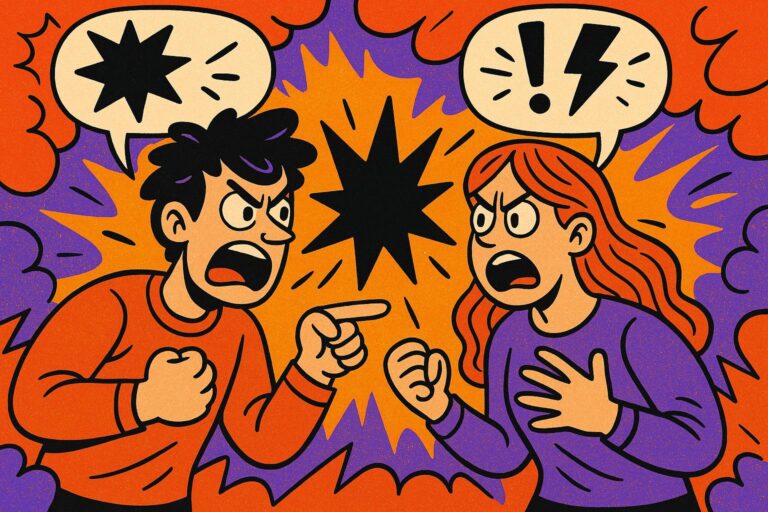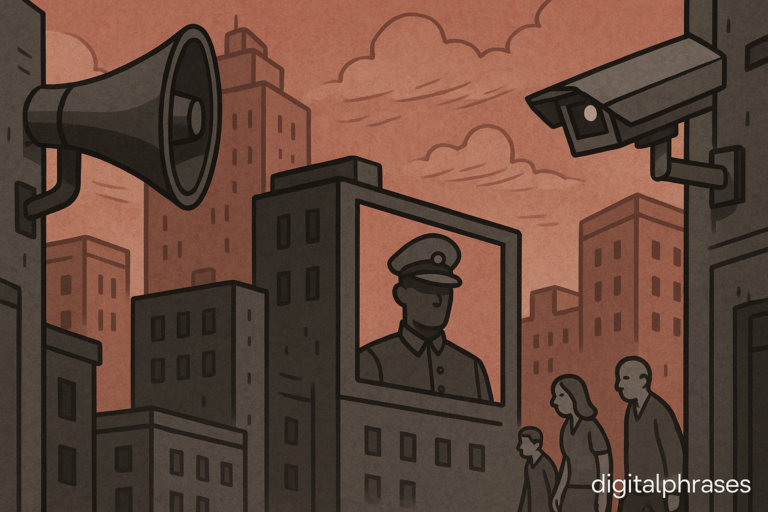How to Write Realistic Dialogue That Actually Sounds Real
Writing dialogue that sounds real is one of the trickiest things to nail—even for seasoned writers.
And I’m not talking about just “realistic enough.” I mean the kind of dialogue that feels so alive you forget you’re reading. Funny thing? Realistic dialogue isn’t actually real. If you’ve ever transcribed an actual conversation, you know it’s mostly filler, repetition, and half-thoughts. Total snoozefest on the page.
What we’re really chasing is the illusion of reality. That sweet spot where a character’s voice sounds spontaneous, but every line is quietly working—revealing who they are, pushing the story, planting tension.
Like in Fleabag, when Claire says, “The only person I’d run through an airport for is you.” It’s short, understated, and says so much more than a grand emotional monologue ever could.
Thing is, most bad dialogue fails because it’s too polished, too on-the-nose, or—ironically—too “writerly.” As pros, we know structure and technique cold.
But it’s easy to forget that people don’t talk in theme statements. They hedge. They contradict themselves. They talk around the truth.
So let’s dig into how to craft dialogue that’s not just functional, but vibrantly real.
The Nuances of Naturalism in Dialogue
The biggest myth about realistic dialogue?
That it should be a perfect replica of real conversation. Nah. Real conversations are chaotic. They zigzag, stall, fizzle. If you’ve ever recorded people talking and tried to transcribe it, you know how much of it is useless on the page.
What works in real life rarely works in fiction — and yet, we’re still aiming to evoke that same energy.
Here’s how to thread the needle between “sounds real” and “actually works.”
1. Rhythm Over Grammar
People rarely speak in full, grammatically correct sentences. Even highly educated characters slip — and that’s not a flaw. It’s texture.
- A professor might say, “No, wait—okay, let me back up,” instead of, “Allow me to explain from the beginning.”
- A kid wouldn’t say, “I have not seen it,” — they’d say, “Didn’t see it.”
If your dialogue reads like a well-punctuated essay, it’s probably dead on the page.
Tip: Break your own sentence structure habits. If a character’s lines always end in periods, throw in dashes, ellipses, abrupt stops. Real rhythm lives in the mess.
2. Subtext Is Doing the Heavy Lifting
Here’s where it gets interesting: the best dialogue happens between the lines. What characters say is only half the story — what they’re avoiding says more.
Let’s say a character says, “You look nice tonight.” Innocent? Maybe. But if we know they’ve just broken up, suddenly it’s a loaded statement.
This is where seasoned writers shine. You don’t need characters to say “I still love you.” You need one of them to say, “Is that the same jacket from… before?” and the silence that follows says everything.
Subtext exists in:
- Avoidance or deflection (“Yeah, well, you’d know, wouldn’t you.”)
- Passive aggression (“Oh, I didn’t realize we were doing honesty now.”)
- Misdirection (talking about the weather instead of the fight that just happened)
Don’t just write what they say — write what they don’t want to say.
3. Everyone Talks Differently. Seriously.
This seems obvious, but it’s wild how often expert writers default to a single “writer voice” that bleeds into multiple characters. You want each person to be identifiable by voice without needing tags.
Key elements that shape voice:
- Vocabulary: A corporate lawyer vs. a skateboarder? Totally different word banks.
- Pacing: Some people talk in long, winding ideas; others are blunt.
- Tone: Sarcasm, warmth, formality, insecurity — all shift how someone speaks.
- Backstory: Where they’re from, what they’ve survived, who they want to be — it all leaks into how they speak.
A good trick? Pick two characters in a scene, remove the dialogue tags, and see if you can tell who’s speaking. If you can’t, their voices aren’t distinct enough.
4. Realistic ≠ Boring
This is where realism trips people up. In real life, people say “hi” and “how are you?” and small talk their way through a conversation. That’s fine in life — but on the page? It’s filler.
Cut the parts readers will skip.
You don’t need the “hello” and “goodbye” unless they’re doing emotional work. Same with chit-chat.
For example:
Instead of:
“Hey.”
“Hey, what’s up?”
“Not much. You?”
“Just got back from the store…”
Try:
“They didn’t have the wine you like.”
“So you got the kind you like instead.”
“Well, it is my birthday.”
“Wow. You’re really going to pull that card.”
Now we’re in it — relationship tension, stakes, voice — and we skipped all the fluff.
5. Characters Lie, Ramble, and Contradict Themselves
One of the quickest ways to make dialogue too perfect is to have characters speak in polished, logical thought arcs. But people are messy.
- They talk themselves into corners.
- They say one thing and mean another.
- They revise their thoughts mid-sentence.
Let your characters contradict themselves. Let them be unaware of their own motives. It’s way more believable.
“I don’t care what she thinks—wait, that’s not true. I mean, I care. I just don’t want to care.”
Boom. Internal conflict, voice, realism — all in one line.
6. Read It Aloud or Better: Get Someone Else To
Here’s a brutal but helpful trick: have someone else read your dialogue out loud. Not an actor — just a normal person. If they stumble or laugh at the wrong time? That’s data.
Reading it aloud yourself is helpful too, but your brain fills in gaps. A fresh voice won’t.
7. Write the Silence
Not every beat needs dialogue. Sometimes what’s not said is doing more work than a monologue ever could.
Use action beats, pauses, and silence to carry emotional weight. Dialogue breathes better when it’s not stacked line after line like a ping-pong match.
Example:
Instead of:
“So, are you going to tell me what happened?”
“Nothing happened.”
“Don’t lie to me.”
“I’m not.”
“I saw the photos.”
Try:
“Are you going to tell me what happened?”
He looks away.
Silence.
“I saw the photos.”
Suddenly, there’s tension. Space. Weight. Let the silence say what the words won’t.
So yeah, real dialogue isn’t “real.” But it feels real when you get the layers right — rhythm, subtext, voice, tension. Think of it as controlled chaos: wild on the surface, but precise underneath. That’s the craft.
Techniques That Sharpen Dialogue Instantly
Okay, so you’ve got your characters, you’ve nailed their voices, and the scene feels alive… kinda. But the dialogue still isn’t hitting quite right. Sometimes it’s just flat. Other times it’s trying too hard. The good news? Dialogue is incredibly tweakable. A few surgical changes can shift it from “meh” to magnetic.
Here are practical, repeatable techniques I use (and steal from screenwriters, playwrights, and novelists I admire) to tighten and elevate dialogue without killing its spark.
1. Read It Out Loud — Then Read It Wrong
Yeah, yeah, we’ve all heard “read it out loud.” But here’s the twist: read it out loud the wrong way on purpose.
Misplace the emphasis. Speed up. Slow down. Interrupt yourself mid-line. It’s wild how quickly you’ll hear which lines are too stiff or too clever for their own good.
For example:
“I didn’t say she stole it.”
This line has seven different meanings depending on which word you stress.
Try each version. Which one sounds like your character? Which one gives the line emotional weight? This trick reveals hidden layers — or shows you that maybe there are no layers, and the line needs rewriting.
Pro Tip: Record yourself. Listen back later with no context. If it sounds like writing instead of speech, tighten it.
2. Strip the Tags (Temporarily)
In your next revision, try removing every dialogue tag (he said, she said, etc.) and ask yourself:
- Can you tell who’s talking just by the voice?
- Does the rhythm or word choice shift with each speaker?
If the answer’s no, there’s probably too much sameness in tone. Good dialogue doesn’t rely on tags to make characters distinct — they sound distinct.
Once you’ve tested it, add the tags back sparingly where clarity’s needed, or better yet, swap them with character-specific beats.
Example:
Instead of:
“You always do this,” she said.
Try:
“You always do this.” She folded the laundry too tightly, every corner creased like she was angry at the fabric.
Now the emotion’s baked into the beat — not just the line.
3. Use Interruptions and Incomplete Sentences
Real people rarely speak in full thoughts. They overlap, interrupt, trail off. They change direction mid-sentence or bail out when it gets too real. On the page, that kind of messiness is gold — it makes everything feel less scripted.
Instead of:
“I just think maybe you should reconsider the decision you made earlier.”
Try:
“I just think—look, maybe… maybe you should think about it. Again.”
Even better? Let characters interrupt each other when they’re emotionally charged:
“You said you’d—”
“No. I didn’t say anything. You assumed.”
Bonus: Use the em dash (—) for interruptions, and the ellipsis (…) for trailing off. It’s a visual cue for rhythm and pacing.
4. Limit Exposition in Dialogue
Here’s a killer of otherwise great scenes: info-dump dialogue where characters say things they already know just so the reader will know it too.
You know the kind:
“As you know, we’ve been siblings for thirty years, and ever since Mom died in that tragic skydiving accident, things haven’t been the same.”
Stop. Nobody talks like that.
If you must drop backstory, layer it into the conversation with tension, stakes, or resistance.
“You really think a birthday card makes up for the last ten years?”
“It’s been five.”
“Feels longer. Ever since Mom died—”
“Don’t.”
Now we get the history and the emotion — without the forced exposition.
5. Allow for Silence, Beats, and Space
Some of the most powerful lines aren’t lines at all — they’re what happens between them.
You don’t always need a witty comeback. Sometimes the most honest response is a pause, a glance, or a character walking away mid-sentence. Don’t overwrite those moments.
Example:
“I didn’t mean to hurt you.”
She looks at him.
Nothing.
“Okay,” she says, finally. “But you did.”
Let the air around the dialogue do the heavy lifting. It gives the reader space to feel the tension.
6. Eavesdrop (Yes, Really)
Next time you’re on a train, in a café, in line at the grocery store — listen. Not just to the words, but to the weird, wonderful cadence of real people speaking when they don’t think anyone’s watching.
You’ll pick up on:
- Unfinished thoughts
- Strange turns of phrase
- Repetition that actually feels meaningful
- Emotional beats buried under small talk
Start a “dialogue diary.” Keep a note on your phone. Record snippets that stick with you. You’re not copying — you’re building a subconscious catalog of how people talk.
7. Avoid Phonetic Spellings for Accents or Dialects
This one’s tricky. Writers love “realism,” and accents are tempting, but spelling things phonetically (e.g., “Ah dunno whatchu mean, matey”) can get tiresome fast. Worse, it can stereotype or alienate.
Instead, suggest dialect and culture through rhythm, word choice, idioms, and syntax.
“You know what your problem is? You think the whole world’s gonna wait for you just ’cause you showed up.”
That line has a voice. We hear a regional pattern, but we’re not bogged down with apostrophes and missing letters.
Tip: Let readers hear the voice in their head. Don’t force them to decode it.
8. Use Echoes and Callbacks
Great dialogue has memory. A line said early in a scene — or earlier in the book — can echo back later with new meaning.
Early:
“I’m not like you.”
“No, you’re not. You still believe people change.”
Later:
“You were right.”
“About what?”
“I’m not like you.”
That callback lands hard — because we remember the original moment, and the echo recontextualizes it. Think of these like emotional boomerangs: they come back heavier.
9. Cut the Clever — Unless It’s Earned
Snappy, clever dialogue can be great — if it suits the character and the moment. But forced cleverness kills stakes.
Real people aren’t walking punchline machines.
If your character drops a perfectly timed one-liner in the middle of their emotional breakdown, ask yourself: is this serving them, or are you showing off as a writer?
Let cleverness rise out of tension, fear, or control. The most biting lines come from characters trying to protect themselves.
“You hurt me.”
“You’re fine.”
“I meant emotionally, but yeah, thanks for the medical evaluation.”
That works — because it’s not just a joke, it’s a defense mechanism.
10. Let Dialogue Be a Reveal — Not a Report
The best dialogue doesn’t just communicate — it reveals something unexpected. It flips what the reader (and sometimes the character) thought they knew.
“I never loved you.”
“I know.”
“…But I loved the way you looked at me.”
That third line opens a whole new world of understanding — regret, vanity, dependency. It’s layered. Revealing. That’s what you want your dialogue to do.
Final Thought (But Not a Conclusion)
If there’s one pattern here, it’s this: realistic dialogue is emotional truth in disguise. It’s not about mimicking how people talk — it’s about recreating how people feel when they talk. The hesitation. The avoidance. The tiny betrayals. The things we say because we don’t know how to say what we really mean.
So go back into your scenes.
Read them out loud.
Pull them apart.
Listen harder.
And when in doubt?
Let the characters talk over you for a bit. They usually know what they’re trying to say.






